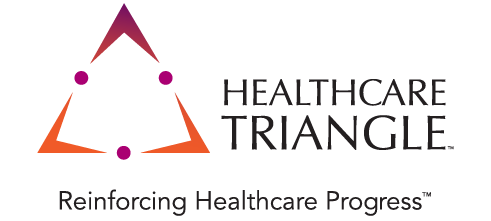3 Top Questions About Digital Transformation in Healthcare Answered
Healthcare Triangle
Sep 09, 2021
What is the key to driving digital innovation with data analytics—and where should healthcare leaders begin?
In a recent webinar hosted by CHIME, Ashleigh Rogers, Vice President, Healthcare at Healthcare Triangle, and Sudish Mogli, Chief Technology Officer at Healthcare Triangle, broke down common barriers to digital innovation and shared real-world insight on how to overcome them.
Digital innovation is happening, pulled along in some cases by the recent pandemic. Nearly one-in-three healthcare organizations will deploy virtual assistants for patient triage, and 35% will shift workflows outside the EHR to deliver better digital experiences by 2023, a Gartner analysis found. These are just a couple of examples among many. Achieving and sustaining these types of innovation depends on being able to capture and analyze data and then make it useful and actionable.
Six-in-10 healthcare leaders say their organization struggles with incomplete or poor-quality data. Virtually the same number say they don’t have a strong data analytics function either. It’s time for these organizations to focus on using digital transformation to:
- Strengthen data capture and retrieval
- Turn up investments in data analytics
- Make the move to cloud-based data security and management
- Hone in on data-based innovation
When they do, they can see the benefits that were shown during the webinar in the case study of a mid-sized health system in South Dakota, which leveraged AI and machine learning to automate the process of categorizing data from unstructured reports and recognize and extract information from documents, faxes, and narrative reports. As a result, this system was able to:
- Streamline patient care through faster processing
- Reduce costs through labor savings
- Improve accuracy through use of the latest AI and language processing models
- Enhance efficiency and access to error-free data
After the webinar discussion and presentation of case studies, attendees had several questions. Most of them centered around how to get started with digital innovation and how to ensure data is kept safe and secure. Here are the answers to the top three most commonly asked questions:
1. Moving to the cloud seems like a big undertaking.Where shouldwe start?
Based on our experience working with many healthcare systems, there isn’t a one-size-fits-allapproach to making the transition to the cloud. We would encourage you to find a workflow or a problem that you want to solve, specifically on the cloud. In the webinar, we gave an example of a health system that hadn’t used the cloud for anything. Its leaders came to us with a very specific problem and asked, “How do we solve this challenge?” That is a good way to get started:one thing at a time.Otherwise, you may be trying to take on a complex project of moving huge platforms, transforming workflows and more all at once. Start with a single problem and go to a partner with experience for ideas on how to approach it. One of the advantages of working in the cloud is that you can start small and build out your capabilities over time, especially in aa pay-as-you-go cloud model that allows you to pay for only what you use. If you’re concerned with the cost to evenget started, a lot of cloud providers are willing to fund proof of concepts to help you make the initial move and see if your problem can be solved in the public cloud. We certainly have done that.
2. How can we ensure that patient privacy is being protected if we have patient data in the cloud?
It’s important to work with cloud providers who are experienced and have the system automation already in place to ensure security and compliance. For example, AWS hosts the government cloud, which obviously has to be very secure. Many of our clients are housing patient data. An experienced cloud vendor will already have the appropriate safeguards in place and will articulate how these protections mitigate risk.
3. Which projects are good candidates for the cloud—and whichones are not?
There are some projects that are very easy to deploy in the cloud, like data backup and disaster recovery. These are great use cases because with a self-serve cloud platform, you only pay for these services when you use them. Another good use case is in moving research data and analysis to the cloud. We’ve seen companies like Epic, Mayo, and Roche leverage the cloud for research-based data sharing and analysis, and it holds strong potential to support advancements in precision medicine and personalized healthcare.
When it comes to projects that don’t make sense for the cloud, there are a couple of things that come to mind. First, if you have a legacy system that is working really well as is, then it probably doesn‘t make sense to change it. It also may not make sense to move high-production software like your EHR to the cloud. It can be done, but you want to be much further along and at the point where you have created a Cloud Center of Excellence and have a high level of cloud knowledge and experience before undertaking an initiative of this scope.
As the webinar and this Q&A show, there are many benefits to moving to the cloud, but it’s best to start small, test your use case and grow over time, adding projects as you become more adept in leveraging a cloud-based platform.
Drop an email to info@healthcaretriangle.com or schedule a consultation.
Sources:


